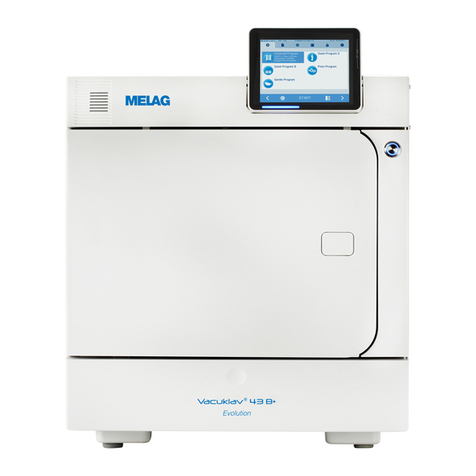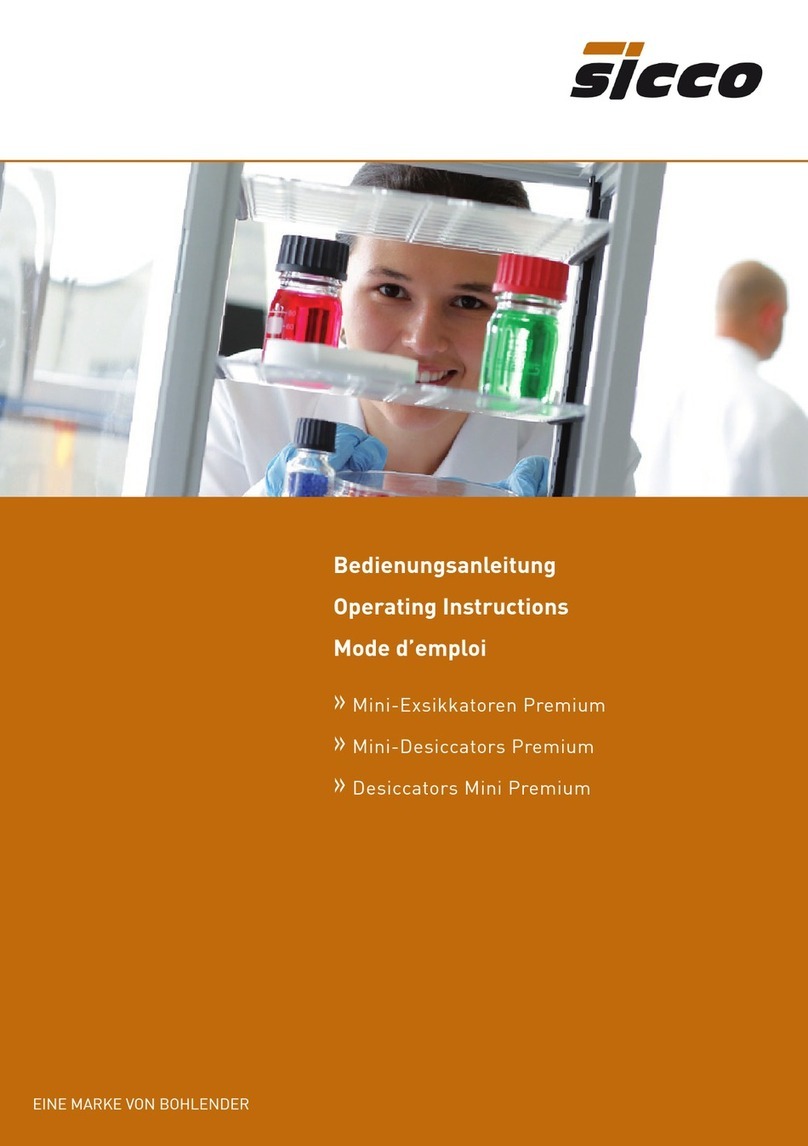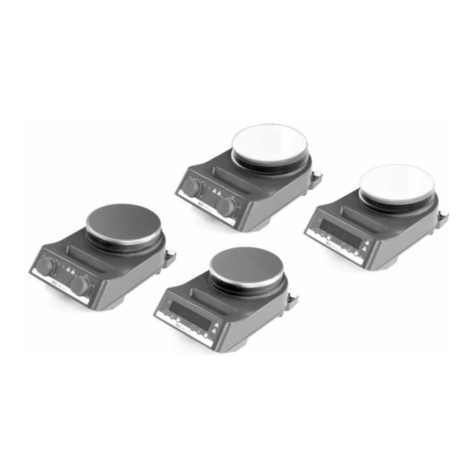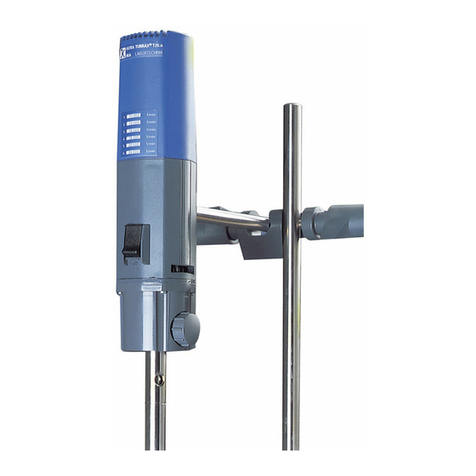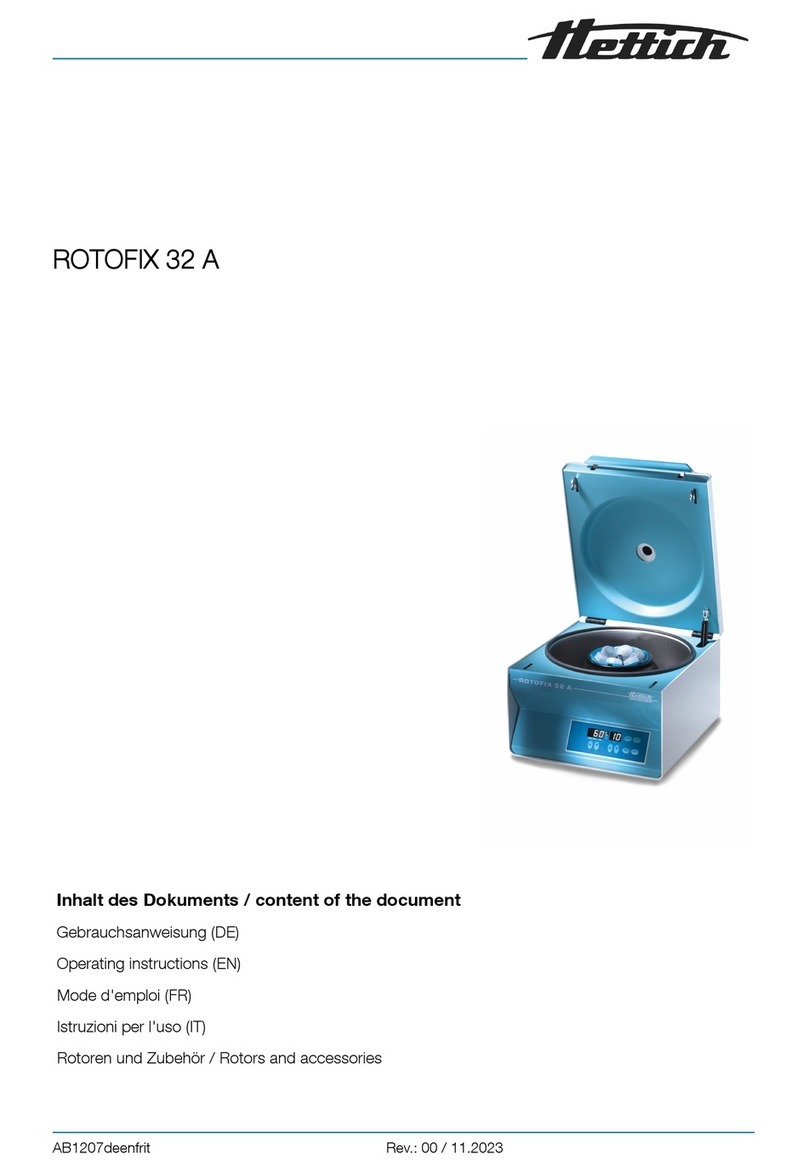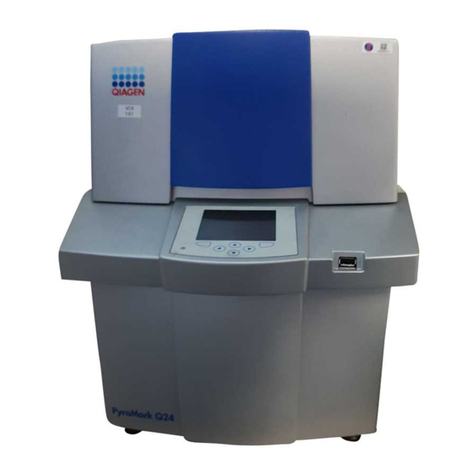Hitachi Koki CS150NX User manual

HITACHI
TABLETOP
MICRO ULTRACENTRIFUGE
CS150NX
INSTRUCTION MANUAL
●The appearance or specification of the products covered in this manual is
subject to partial change for improvement.
-
Important
-
Before using this CENTRIFUGE carefully read
through this INSTRUCTION MANUAL to ensure
efficient, safe operation.
Keep this INSTRUCTION MANUAL available as an
important reference when using the CENTRIFUGE.
MFG.No. CAT.No. Manual code
S99806110
2014.11


Copyright © 2013 Hitachi Koki Co., Ltd.
All rights reserved. No part of this document may be reproduced or transmitted in any form or any means without
permission from Hitachi Koki Co., Ltd.
The names of actual companies and products mentioned herein may be the trademarks of their respective owners.

General description
The CS150NX is designed to separate liquid-suspended materials having different densities and
particle size.
The CS150NX is a product that pursues user-friendliness and reliability based on our many years
of experience in developing centrifuges. This centrifuge offers many features that we are confident
of satisfying your requirements. These features include the following.
1. The maximum speed is 150,000 rpm (1,050,000 x g).
2. Small and compact tabletop type
3. The touchscreen with easy-to-see color liquid crystal screen is incorporated.
4. The displayed language can be switched over between Japanese and English.
5. Various alarm indications can notify users of the causes and necessary actions of the troubles.
It can realize troubleshooting easier and quicker.
6. The rotor can be set by simply mounting it on the drive shaft in the rotor chamber (quick setting
type.)
7. Samples can be easily balanced visually (see Section 2-1-2).
8. This product spins very quietly, and is thus well suited for personal use.
9. A CFC-free thermomodule cooling system is employed featuring a powerful cooling capacity.
(Samples can be kept at 0℃at maximum speed when the ambient temperature is 30℃. )
10. The real-time control (RTC) feature enables setting a start time or a finish time, thus letting you
run your machine at a desired date and time.
11. Centrifugal force (RCFmax and RCFavg) can be displayed and set (Note 1).
12. Twenty varieties of nine stepped modes can be programmed for a wide range of applications
such as step running.
13. In addition to a door lock and an imbalance detector, two independent microprocessors are
incorporated for overspeed detection (a dual CPU overspeed prevention mechanism) for
even greater safety.
4
Note 1: RCF: Relative Centrifugal Force

i
SAFETY NOTICES
Safety reminders
Carefully read and fully understand the following safety instructions.
● Operate your instrument according to the instruction manual.
● Be sure to observe the all safety precautions in the instruction manual and safety
instructions on your instrument. If neglected, personal injury and/or instrument damage
can be caused.
● If the equipment is used in a manner not specified by the manufacturer, the protection
provided by the equipment may be impaired.
● The safety reminders are indicated as shown below. The signal words "DANGER",
"WARNING" and "CAUTION" are indicated together with the hazard alert symbols in this
manual.
"NOTE" indicates a note which has no direct bearing on personal safety.
Do not perform any operation not specified in the instruction manual. If any problem is
found on your instrument, contact a Hitachi Koki authorized sales/service representative.
Although the safety precautions in the instruction manual and safety instructions on your
instrument have been fully considered, an unexpected situation may arise. Observe the
instructions in the instruction manual and always be careful yourself when operating this
instrument.
DANGER:This note indicates an imminently hazardous situation, which if not
strictly observed, could result in personal severe injury or possible
death.
WARNING:This note indicates a potentially hazardous situation, which if not
strictly observed, could result in personal severe injury o
r
possible death.
CAUTION:This note indicates a potentially hazardous situation, which if not
strictly observed, could result in personal injury or severe damage
to the instrument.
This hazard alert symbol indicated together with a signal word is a
reminder to emphasize important safety instructions.

ii
SAFETY NOTICES
○Mechanical Safety
● Do not open the door while the rotor is spinning.
● Do not attempt to slow or stop the spinning rotor by hand.
● Do not incline or move the instrument while the rotor is spinning. Do not place
any object on the instrument or lean on the instrument.
● Do not attempt to unlock the door forcefully while the rotor is spinning.
● For operator safety, maintain a 30-cm "clearance envelope" around the
instrument while the rotor is spinning. Do not store dangerous substances
capable of developing flammable or explosive vapors on nor near the
centrifuge.
● Repairs, disassembly, and other modifications to the centrifuge are strictly
prohibited unless performed by a Hitachi Koki authorized sales/service
representative.
● Do not use the other’s manufacturer’s rotor without Hitachi Koki’s permission.
● Always use a quick-setting rotor for this ultracentrifuge. The screw-type rotors
are inapplicable.
● Check the chemical resistance chart attached to the rotor, and do not use any
sample inapplicable to the rotor (including the buckets). Using such a
sample could corrode the rotor (including the buckets).
● Do not exceed the maximum rated speed of the rotor or buckets in use.
● Do not use corroded, scratched or cracked rotor and buckets. Check that the
rotor and buckets are free of such abnormalities before operation.
● When using a swing rotor, check that the buckets are properly engaged with
the rotor pins before operation. Wrong setting can cause severe damage to
the instrument. Make sure that all the rotor buckets are of the same type.
● If abnormal sound or vibration occurs, stop the operation immediately and
contact a Hitachi Koki authorized sales/service representative.
● Position the centrifuge on a level surface, such a table or laboratory bench
that can support the weight of the centrifuge and resist vibration.
● Be sure to remove the rotor from the rotor chamber when centrifuge is not
used for a long time or when the machine is moved. Otherwise the drive shaft
(crown) may be damaged.
● Before using a rotor, be sure to read through the rotor instruction manual.
●
Check the chemical resistance chart attached to the rotor, and do not use any
sample inapplicable to the tubes, tube caps, bottles, or bottle caps, etc.
Using such a sample could corrode or deteriorate such parts.
●
Use the rotor tubes and bottles within their actual capacities.
●
Mount the rotor onto the drive shaft gently and properly.
●
Do not drop the rotor or apply excessive force to the drive shaft to avoid
damage to the drive shaft.
●
Maximum rotor speed depends on the tubes or adapters to be used. Follow
the instructions on the rotor instruction manual.
●
This centrifuge might convey vibration to a table while the rotor is rotating. If a
measuring device is positioned on a table and near this centrifuge, use a
measuring device carefully.
●
Approximately even quantities of sample in the tubes are sufficient for
balancing, and extremely different sample quantities must be avoided ( Refer
to Section 2-1-2 for the sample balancing).
●
Clean the inside of the drive hole (crown hole) of the rotor and the surface of
the drive shaft (crown) of the centrifuge once a month.
●
Storing the rotor on the shelf is permitted if the shelf is taken necessary
countermeasures against earthquakes not to drop the rotor.
WARNING:
CAUTION:

iii
SAFETY NOTICES
● Do not pour any solution such as water, detergent, or disinfectant directly into
the rotor chamber and be careful not to spill the sample into the rotor chamber.
If you do so, the bearings of the drive unit might corrode or deteriorate and it
might cause vacuum failure.
● Do not operate the display panel (Touchscreen) using a ball-point pen.
○Safety during installation and maintenance
● Before removing the cover, top deck, or other component for maintenance,
always turn off the POWER switch of the instrument, unplug the power cord
from the wall outlet, and wait at least three minutes to avoid the risk of
electrical shock.
● For maintenance and repairing of the rotors, tubes, etc., see the rotors and
tubes instruction manual.
● After installation and before any test-run, this ultracentrifuge always needs the
internal check by a Hitachi Koki authorized sales/service representative.
● Repairs, disassembly, and other modifications to the centrifuge are strictly
prohibited unless performed by a Hitachi Koki authorized sales/service
representative.
● If the centrifuge is exposed to ultraviolet rays for a long time, the color of the
covers may be changed or the coating may be peeled off. After use, cover
the centrifuge with a cloth to protect it from direct exposure.
○ Electrical Safety
●
Your centrifuge must be grounded properly to avoid electrical shock hazards.
●
Do not place containers holding liquid in the rotor chamber or on or near the
instrument. If they spill, liquid may get into the instrument and damage
electrical components.
●
If the machine will not be used for a long time, turn off the main circuit breaker.
WARNING:
CAUTION:
DANGER:
CAUTION:
CAUTION:
WARNING:

iv
SAFETY NOTICES
○Safety against Risk of Fire
● This centrifuge is not explosion-proof. Never use explosive or flammable
samples or materials that chemically react vigorously. Do not centrifuge such
materials in this instrument nor handle or store them near the instrument.
○Chemical and Biological Safety
● Take all necessary safety measures before using samples that are toxic or
radioactive, or blood samples that are pathogenic or infectious. You use such
samples at your own responsibility.
●
Take all necessary safety measures when Risk Group Ⅱmaterials (as
identified in the World Health Organization “Laboratory Biosafety Manual”) are
handled, and that more than one level of protection shall be provided in the
case of materials of a higher group.
●
If the centrifuge, rotor, or an accessory is contaminated by samples that are
toxic or radioactive, or blood samples that are pathogenic or infectious, be
sure to decontaminate the item according to good laboratory procedures and
methods.
● If there is a possibility that the centrifuge, rotor, or an accessory is
contaminated by samples that might impair human health (for example,
samples that are toxic or radioactive, or blood samples that are pathogenic or
infectious), it is your responsibility to sterilize or decontaminate the centrifuge,
rotor, or the accessory properly before requesting repairs from a Hitachi Koki
authorized sales/service representative.
● It is your responsibility to sterilize and/or decontaminate the centrifuge, rotor,
or parts properly before returning them to a Hitachi Koki authorized
sales/service representative.
Notice for an Earthquake
Depending on the magnitude, an earthquake might damage centrifuge. If you observe some
abnormality, stop using the centrifuge immediately and ask for inspection by the Hitachi Koki
service representative.
WARNING:
WARNING:

v
Table of contents
1. Description ・・・・・・・・・・・・・・・・・・・・・・・・・・・・・・・・・・・・・・・・・・・・・・・・・・・・・・・・・・・・・・・・1-1
1-1 External view of ultracentrifuge ・・・・・・・・・・・・・・・・・・・・・・・・・・・・・・・・・・・・・・・・・・・ 1-1
1-2 Structure ・・・・・・・・・・・・・・・・・・・・・・・・・・・・・・・・・・・・・・・・・・・・・・・・・・・・・・・・・・・・・・ 1-2
1-2-1 Touchscreen ・・・・・・・・・・・・・・・・・・・・・・・・・・・・・・・・・・・・・・・・・・・・・・・・・・・・・・ 1-2
1-2-2 Rotor chamber・・・・・・・・・・・・・・・・・・・・・・・・・・・・・・・・・・・・・・・・・・・・・・・・・・・・・ 1-5
1-2-3 Safety devices ・・・・・・・・・・・・・・・・・・・・・・・・・・・・・・・・・・・・・・・・・・・・・・・・・・・・・ 1-6
2. Operation ・・・・・・・・・・・・・・・・・・・・・・・・・・・・・・・・・・・・・・・・・・・・・・・・・・・・・・・・・・・・・・・・・ 2-1
2-1 Run preparation ・・・・・・・・・・・・・・・・・・・・・・・・・・・・・・・・・・・・・・・・・・・・・・・・・・・・・・・・ 2-2
2-1-1 Starting up this machine ・・・・・・・・・・・・・・・・・・・・・・・・・・・・・・・・・・・・・・・・・・・ 2-2
2-1-2 Preparing tubes/bottles and rotor ・・・・・・・・・・・・・・・・・・・・・・・・・・・・・・・・・・・・ 2-3
2-1-3 Applicable rotors ・・・・・・・・・・・・・・・・・・・・・・・・・・・・・・・・・・・・・・・・・・・・・・・・・・ 2-4
2-2 Basic operation・・・・・・・・・・・・・・・・・・・・・・・・・・・・・・・・・・・・・・・・・・・・・・・・・・・・・・・・・ 2-5
2-2-1 Setting run conditions ・・・・・・・・・・・・・・・・・・・・・・・・・・・・・・・・・・・・・・・・・・・・・・・ 2-5
2-2-2 Operational procedure ・・・・・・・・・・・・・・・・・・・・・・・・・・・・・・・・・・・・・・・・・・・・・・ 2-10
2-2-3 Acceleration rates and deceleration rates・・・・・・・・・・・・・・・・・・・・・・・・・・・・・・・ 2-13
2-3 How to use the option function・・・・・・・・・・・・・・・・・・・・・・・・・・・・・・・・・・・・・・・・・・・・ 2-14
2-3-1 Programmed operation・・・・・・・・・・・・・・・・・・・・・・・・・・・・・・・・・・・・・・・・・・・・・・ 2-15
2-3-2 Step-mode operation ・・・・・・・・・・・・・・・・・・・・・・・・・・・・・・・・・・・・・・・・・・・・・・・ 2-30
2-3-3 Selecting the rotor・・・・・・・・・・・・・・・・・・・・・・・・・・・・・・・・・・・・・・・・・・・・・・・・・・ 2-41
2-3-4 Displaying and setting RCF ・・・・・・・・・・・・・・・・・・・・・・・・・・・・・・・・・・・・・・・・・・ 2-43
2-3-5 User login・・・・・・・・・・・・・・・・・・・・・・・・・・・・・・・・・・・・・・・・・・・・・・・・・・・・・・・・・ 2-47
2-4 Features of the MENU screen ・・・・・・・・・・・・・・・・・・・・・・・・・・・・・・・・・・・・・・・・・・・・・ 2-49
2-4-1 Displaying the Run History and loading the information about run parameters ・・・・・・ 2-50
2-4-2 Rotor Catalog ・・・・・・・・・・・・・・・・・・・・・・・・・・・・・・・・・・・・・・・・・・・・・・・・・・・・・ 2-51
2-4-3 Spin-down operation・・・・・・・・・・・・・・・・・・・・・・・・・・・・・・・・・・・・・・・・・・・・・・・・ 2-52
2-4-4 RTC (real-time control) operation ・・・・・・・・・・・・・・・・・・・・・・・・・・・・・・・・・・・・・ 2-53
2-4-5 Customizing the settings ・・・・・・・・・・・・・・・・・・・・・・・・・・・・・・・・・・・・・・・・・・・・ 2-57
2-4-6 Administrator (Admin) functions・・・・・・・・・・・・・・・・・・・・・・・・・・・・・・・・・・・・・・・ 2-60
2-5 Emergency recovery from power failure・・・・・・・・・・・・・・・・・・・・・・・・・・・・・・・・・・・・ 2-73
3. Maintenance ・・・・・・・・・・・・・・・・・・・・・・・・・・・・・・・・・・・・・・・・・・・・・・・・・・・・・・・・・・・・・・ 3-1
3-1 Rotor Chamber ・・・・・・・・・・・・・・・・・・・・・・・・・・・・・・・・・・・・・・・・・・・・・・・・・・・・・・・・・ 3-2
3-2 Drive Shaft (Crown) ・・・・・・・・・・・・・・・・・・・・・・・・・・・・・・・・・・・・・・・・・・・・・・・・・・・・・ 3-2
3-3 Cabinet・・・・・・・・・・・・・・・・・・・・・・・・・・・・・・・・・・・・・・・・・・・・・・・・・・・・・・・・・・・・・・・・3-2
3-4 Chamber door seal ・・・・・・・・・・・・・・・・・・・・・・・・・・・・・・・・・・・・・・・・・・・・・・・・・・・・・ 3-3
3-4-1 Removing the door seal O-ring ・・・・・・・・・・・・・・・・・・・・・・・・・・・・・・・・・・・・・・・ 3-3
3-5 Vacuum pump・・・・・・・・・・・・・・・・・・・・・・・・・・・・・・・・・・・・・・・・・・・・・・・・・・・・・・・・・・ 3-4
3-6 Others ・・・・・・・・・・・・・・・・・・・・・・・・・・・・・・・・・・・・・・・・・・・・・・・・・・・・・・・・・・・・・・・・3-4

vi
Table of contents
4. Troubleshooting ··········································································································4-1
4-1 Alarm indicators ······································································································4-2
4-2 User-corrected Problems························································································4-4
5. Installation ····················································································································5-1
6. Warranty ·······················································································································6-1
7. Specifications ··············································································································7-1
8. Supply list ·····················································································································8-1
APPENDIX
Decontamination sheet
WEEE Compliance
Marking for Control of Pollution Caused by Electronic Information Products
(THE PEOPLE’S REPUBLIC OF CHINA)

1-1
1. Description
1-1 External view of ultracentrifuge
The CS150NX Ultracentrifuge is tabletop type and requires a small amount of space.
Fig. 1-1 External view of CS150NX Tabletop Micro Ultracentrifuge
1-1 External view of ultracentrifuge
NOTE
Unit: (mm)
External connection
* This size is the minimum size and depends on the installation conditions.
Touchscreen (display/operation)
Front cover
POWER switch
Door
Top deck
590
582
408
*

1-2
(9) Keypad display
1-2 Structure
1-2-1 Touchscreen
The touchscreen with color liquid crystal screen is incorporated in the CS150NX centrifuge. You can set
the run conditions, perform the operation, and display Run History, Programmed Run, and User
Customizations Screens by pressing the screen.
Fig. 1-2-1 shows the touchscreen.
The following screen appears by pressing the SPEED , TIME , or TEMP button.
(7) RTC button
(6) PROGRAM button
(5) STOP button
(4) START button
(3) VACUUM
button/Indicator
1-2-1 Touchscreen
Fig. 1-2-1 Touchscreen
【Display at the normal operation】
(1) Field display
(2) Rotor indicator
Tabs of each screen
(8) USER button
【Display when setting the run conditions such as the speed etc.】

〔Functions of the Run screen〕
1-3
1-2-1 Touchscreen
(1) Field display
SPEED column
(RCF column)
TIME column
TEMP column
Displays various fields.
The SPEED(RCF), TIME, and TEMP fields give the current status indicator in the top
row and the setting indicator in the bottom row. (For setting, see Section 2-2-1.)
SPEED (
Speed indicator)
(Top row) Displays speeds in increments of 10 rpm at lower than 5,000 rpm, and in steps
of 100 rpm at 5,000 rpm or more.
(Bottom row) Sets speeds from 5,000 to maximum speed in increments of 1000 rpm.
The lower three digits (one, ten, and one-hundred positions) display zeros.
Maximum speed: 150,000 rpm
For RCF , see Section 2-3-4.
TIME (running time indicator)
(Top row) Displays the remaining operation time. If the running time is set to
HOLD , this field displays time elapsed.
(Bottom row) Specifies a setting in the range from 1 minute to 99 hours 59 minutes in
steps of minutes and hours.
TEMP (temperature indicator)
When the pressure in the rotor chamber equals the atmospheric pressure, the
temperature of the inside of the rotor chamber is kept at 25℃to prevent
condensation.
(Top row) Displays in steps of 0.1 °C.
(Bottom row) Sets a setting in the range from 0 °C to 40 °C in increments of 1 °C
button
The column is shifted from SPEED (RCF) column to RCF (SPEED)column
by pressing this button.
button
The Acceleration rate and Deceleration rate are set by pressing this button.
ACCEL (acceleration mode indicator)
Displays acceleration modes 1 through 9.
DECEL (deceleration mode indicator)
Displays deceleration modes 1 through 9, along with free coast (F).
(2) Rotor indicator
ROTOR CATALOG is displayed by pressing this button and you can select the
desired rotor.
(3) VACUUM button Press this button to turn the vacuum pump on or off. When the vacuum pump
is turned off, the pressure in the rotor chamber will change to equal the
atmospheric pressure. (While the rotor is rotating, you can not turn off the
vacuum pump.)
Temperature control starts as soon as the vacuum pump is turned on.
Displays the following four stages according to the vacuum of the rotor chamber.
(1)Atmospheric state.
The vacuum pump is not activated.
(2)Low vacuum. The rotor waits at 5,000 rpm until the vacuum
reaches an intermediate level.
(3)Intermediate vacuum.
(4)High vacuum.
No. Name and symbol Functions and actions
If the sample is sensitive to a
temperature rise, do not press
the START button until the
chamber is at a high vacuum
level.
NOTE

〔Functions of the Run screen〕
No. Name and symbol Functions and actions
(4)
button Starts rotor rotation. If VACUUM is off, pressing this button activates
the vacuum pump and starts temperature control.
(5)
button Stops rotor rotation.
(6)
button Displays the program No. if program operation has been selected.
Press this button to specify program settings (see Section 2-3-1).
(7) button Displays the start time or finish time for centrifugation. Press this
button to set a start time or finish time (see Section 2-4-4).
(8)
button Displays the user name (see Section 2-4-6).
1-4
〔Functions of the keypad display〕
No. Name and symbol Functions and actions
(9) Keypad display
When entering the deceleration
rate, is displayed in the
position of .
Use the keypad display to enter numeric values for run parameters.
When entering a time: Switches from hours to minutes
When entering the operation time: Sets continuous running.
When entering deceleration conditions: Sets free coasting.
Press this to cancel input (for example, if you enter the
wrong number or the wrong value for a run parameter).
Press this to save the entered setting.
Press this to close the keypad display.
Enter
X
CE
FREE
Hold
:
FREE
Hold
〔External connection〕
No. Name and symbol Functions and actions
(10) USB (host side)
Use the USB connection to output the operation history of the
centrifuge to a USB flash drive.
(11) USB (device side)
Use for connecting optional items.
⑩
⑪
1-2-1 Touchscreen

1-5
1-2-2 Rotor chamber
The structure of the rotor chamber (vacuum chamber) is shown in Fig. 1-2-2.
Chamber door seal
1-2 Structure
Fig. 1-2-2 Rotor chamber
Drive shaft (crown)
Sets the rotor and rotates.
Cooling bowl (Rotor Chamber)
Cools the rotor.
Protector
(Protection steel tube)
Temperature senso
r
Measures the temperature in the
rotor chamber.
Imbalance detection device
Detects abnormal balance and
stops the rotor.
Over-speed sensor
Stops the rotor when it rotates
faster than the maximum
allowable speed of the rotor.
(Two sensors provided)

1-6
1-2-3 Safety devices
(1) Protection of rotor chamber
Should the rotor spinning at high speed fails (or comes off the drive shaft), the safety of the operator is
ensured by the thick protector (Protection steel tube) enclosing the cooling bowl (Fig. 1-2-2).
(2) Imbalance detector
If during operation the vibration of the rotor becomes excessive due to serious imbalance or improper
bucket setting, the imbalance detector detects the situation and decelerates the rotor immediately.
However, the ultracentrifuge is designed to tolerate imbalance associated with visual balancing-it is
equipped with an imbalance tolerant drive. (For more information on the balancing of rotors, see
Section 2-1-2 "Preparing tubes/bottles and rotor".)
(3) Door lock system
The chamber door automatically locks for safety while the rotor is spinning. When the power supply is
off, the door remains locked. The door can only be opened and closed when the rotor is at rest and the
rotor chamber is vented. To open the door in the event of a power failure, see Section 2-5 "Emergency
recovery from power failure".
(4) Overspeed detector
This ultracentrifuge incorporates a detector designed to prevent the rotor from spinning at a speed
exceeding the maximum allowable speed.
Two independent microprocessors (CPUs) check the rotor for overspeed, thus increasing safety further
(dual CPU overspeed preventive mechanism).
The first CPU detects overspeed and performs control and display. Should the rotor be set to a speed
exceeding the permissible speed, this CPU detects an alarm massage of “SPEED” from the low speed
range (about 2,000 rpm), and stops the rotor.
(But this second CPU does not display an alarm message, because it is not connected to the display-
performing CPU. Should the alarm device be activated, pressing START button will not run the
instrument. Turn off the POWER switch, wait for several minutes, turn the POWER switch on again,
then pressing START button.)
1-2 Structure

2-1
2. Operation
The CS150NX Ultracentrifuge is capable of operation in more than one mode to meet a wide range of
applications. The outline of each available mode is given below:
Brief description Reference
Normal operation
Section 2-2,
Basic operation
Programmed operation
You can store set run conditions in memory
for later use in repeated operation. Section 2-3-1,
Programmed operation
Step-mode operation
More than one normal operation can be
combined into a sequence of operations or
step for successive centrifugation. Section 2-3-2,
Step-mode operation
RCF (centrifugal force)
value display setting
This feature calculates centrifugal force (RCF)
values from set speed.
It can also calculate reversely, i.e., finding
speed from such values.
Section 2-3-4,
Displaying and setting
RCF
Spin-down operation Section 2-4-3,
Spin-down operation
フ
ァ
ン
ク
シ
ョ
ン
RTC (real-time control)
operation
Run starts or completes at a required date
and time. Section 2-4-4,
RTC (real-time control)
operation
Time
Speed
Time
Time
Speed
Speed
Store Call
Speed
Time
Other features
Press START
button.
Time
A
finish date and
time required
Speed
2. Operation
RCF value
setting
Speed
Time
Program No.
Spin-down operation is useful to remove the
adhered samples on the interior walls of the
tubes.

2-2
2-1 Run preparation
WARNING:1. This centrifuge is not explosion-proof. Never use explosive or flammable samples, or
materials that chemically react vigorously. Do not centrifuge such materials in this
instrument nor handle or store them near the instrument.
2. Take all necessary safety measures before using samples that are toxic or radioactive,
or blood samples that are pathogenic or infectious. You use such samples at your
own responsibility.
CAUTION :Do not place containers holding liquid in the rotor chamber, on the centrifuge, or near the
centrifuge. If spilt, liquid might get into the instrument and damage electrical and
mechanical components.
2-1-1 Starting up this machine
Before setting run conditions, display the Run screen (Screen for setting run conditions)
(1) Displaying the Run screen (Screen for setting run conditions)
1. Turn on the POWER switch.
2. The initial screen appears.
3. The Run screen appears.
Run screen
Fig.2-1-1 Initial screen and Run screen
Initial screen
2-1 Run preparation

2-3
2-1-2 Preparing tubes/bottles and rotor
The CS150NX allow you to balance, by eye, tubes or bottles containing a sample solution and then centrifuge
them. Make sure that the approximate difference between meniscus levels of sample solution in tubes or
bottles is within 5 mm (See fig. 2-1-2).
Fig. 2-1-2 Balancing tubes/bottles containing a sample solution
CAUTION :Do not run the ultracentrifuge in an extremely imbalance condition. This might cause a
mechanical failure. When balancing tubes or bottles by eye, alarm message
“IMBALANCE” might appear. Balance tubes or bottles more accurately again if alarm
message “IMBALANCE” appears.
Depending on the type of tube or rotor combined with this machine, an excessively low liquid level may limit
the speed or crush the tube.
• When sealed tubes are used, fill the tubes with liquid to the full level.
CAUTION :1. Before using a rotor, read the rotor instruction manual carefully.
2. Do not use any corroded, scratched, cracked, or otherwise damaged rotor or bucket.
Before operation, always check if there is no corrosion and damage on the rotor
surface.
3. Before running a swing rotor, make sure that each bucket is hooked on a pin securely.
Poor setting might seriously damage the instrument. Even though all of them are not
used, make sure to install all buckets at any time. Make sure that all the rotor buckets
are of the same type.
4. Some tubes and adapters are inapplicable at the maximum speed of the rotor.
Refer to the rotor instruction manual carefully.
5. The S58A rotor, S55A rotor, and S50A rotor can handle sample whose mean density is
1.2 g/ml or less.
Do not rotate this rotor at its maximum speed when using a sample whose mean
density is over 1.2 g/ml. Refer to the rotor instruction manual (Part No. S999276) for
how to limit the maximum speed when using a sample whose mean density is
over 1.2 g/ml.
Within 5mm
Tubes
2-1 Run preparation
For an S140AT rotor, an S100AT5 rotor, and an S50
A
rotor, set the approximate meniscus level difference to
within 3 mm, and for an S110AT rotor and an S80AT3
rotor, set it to within 4 mm.

2-4
2-1-3 Applicable rotors
Rotors applicable to the CS150NX are limited to the quick setting type illustrated below. A quick setting rotor
can be installed by merely placing it on the drive shaft (crown) in the rotor chamber. Screw-type rotors used in
older models (CP120H/CP100H, CS120/CS100, CS120EX/CS100EX, and CS120FX/CS100FX) are
inapplicable to the CS150NX.
CAUTION :1. Always use a quick setting rotor for this ultracentrifuge. The screw-type rotors are
inapplicable.
Quick-setting rotors are not applicable in older models (CP120H/CP100H,
CS120/CS100, CS120EX/CS100EX, and CS120FX/CS100FX).
2. Install the rotor carefully and securely on the drive shaft in the rotor chamber. Forcefully
moving the shaft sideways or dropping the rotor onto the drive shaft may damage the
shaft.
3. The S52ST swinging bucket rotor and S50ST swinging bucket rotor are specifically
designed for the CS150NX, CS-GXⅡseries, and CS-GXL series ultracentrifuges.
These rotors cannot be used in any other centrifuge.
2-1 Run preparation
Cap (blue)
(without a screw hole)
Cover (black)
(1) Applicable rotor (2) Inapplicable
Rotor set handle
Screw cap (with a screw hole)
Cover (blue)
Quick setting type Screw – type for older models
Table of contents
Popular Laboratory Equipment manuals by other brands

Owen Mumford
Owen Mumford AutoSqueeze OP6100 instructions
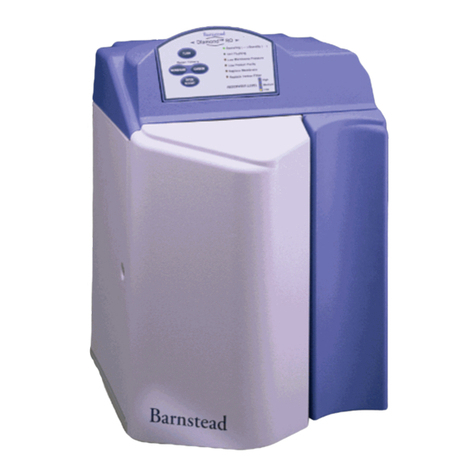
Barnstead International
Barnstead International DIamond 1265 Series Operating manual and parts list
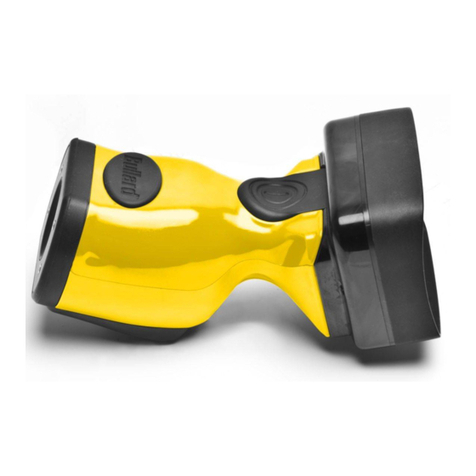
Bullard
Bullard Eclipse LD user manual
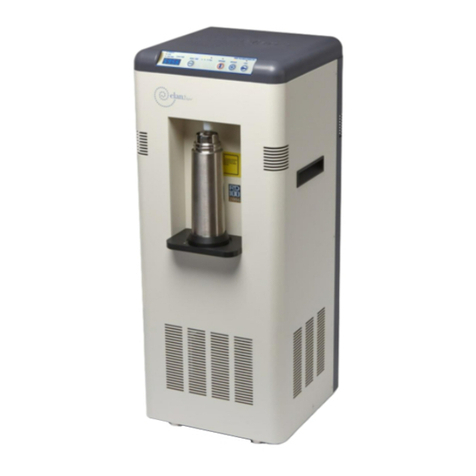
MMR Technologies
MMR Technologies elan2 digital user manual
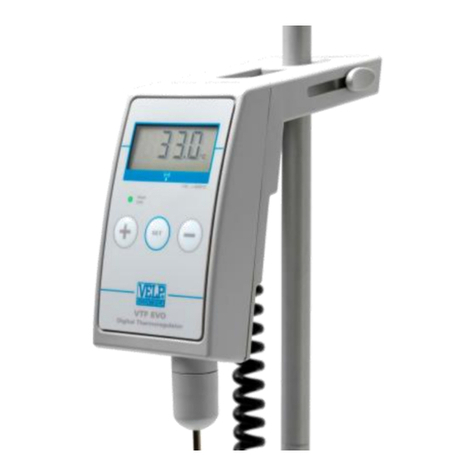
Velp Scientifica
Velp Scientifica VTF F208B0063 instruction manual
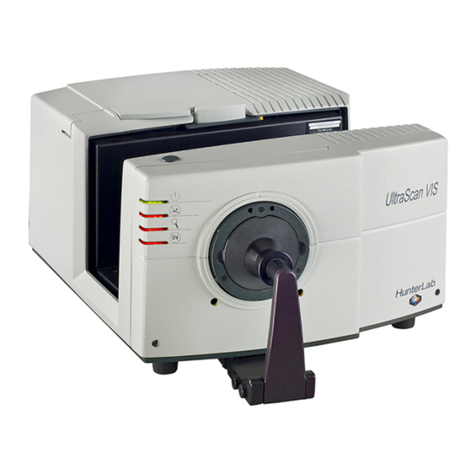
HunterLab
HunterLab EasyMatch QC user manual




